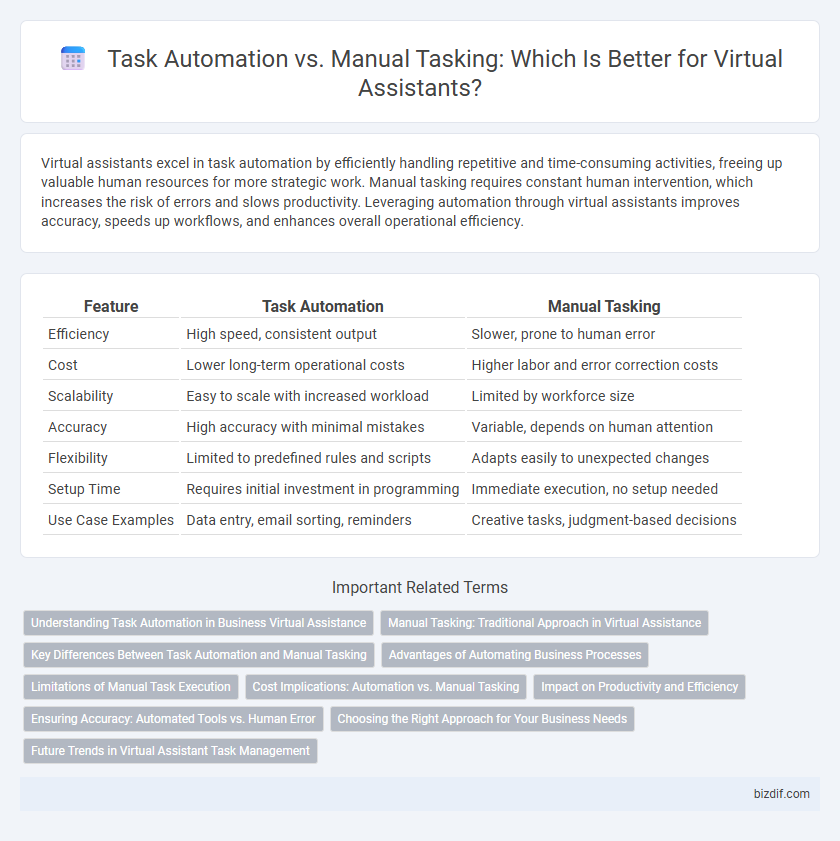Virtual assistants excel in task automation by efficiently handling repetitive and time-consuming activities, freeing up valuable human resources for more strategic work. Manual tasking requires constant human intervention, which increases the risk of errors and slows productivity. Leveraging automation through virtual assistants improves accuracy, speeds up workflows, and enhances overall operational efficiency.
Table of Comparison
| Feature | Task Automation | Manual Tasking |
|---|---|---|
| Efficiency | High speed, consistent output | Slower, prone to human error |
| Cost | Lower long-term operational costs | Higher labor and error correction costs |
| Scalability | Easy to scale with increased workload | Limited by workforce size |
| Accuracy | High accuracy with minimal mistakes | Variable, depends on human attention |
| Flexibility | Limited to predefined rules and scripts | Adapts easily to unexpected changes |
| Setup Time | Requires initial investment in programming | Immediate execution, no setup needed |
| Use Case Examples | Data entry, email sorting, reminders | Creative tasks, judgment-based decisions |
Understanding Task Automation in Business Virtual Assistance
Task automation in business virtual assistance streamlines repetitive processes by leveraging AI and software tools to execute tasks without human intervention, significantly reducing time and errors. Manual tasking requires human input for each step, resulting in slower workflows and increased potential for mistakes. Implementing task automation enhances efficiency, allowing virtual assistants to manage higher volumes of work while focusing on strategic, value-driven activities.
Manual Tasking: Traditional Approach in Virtual Assistance
Manual tasking in virtual assistance relies heavily on human intervention for every step, leading to increased time consumption and potential for human error. This traditional approach involves repetitive, low-level tasks such as scheduling, email management, and data entry, which often results in decreased efficiency and higher operational costs. Despite its limitations, many businesses still depend on manual tasking due to the perceived need for personalized judgment and flexibility in handling complex requests.
Key Differences Between Task Automation and Manual Tasking
Task automation leverages software and AI to execute repetitive tasks efficiently, reducing human error and increasing productivity, whereas manual tasking relies on human intervention, which can be time-consuming and prone to inconsistencies. Key differences include scalability, with automation handling large volumes seamlessly while manual processes face capacity constraints, and adaptability, as automated systems can integrate with digital workflows to provide real-time updates and analytics. Cost-effectiveness is another factor, as automation reduces labor costs over time despite initial setup expenses, in contrast to ongoing operational costs associated with manual task execution.
Advantages of Automating Business Processes
Automating business processes with virtual assistants significantly increases efficiency by reducing human error and accelerating task completion times. It enhances scalability by enabling consistent handling of repetitive tasks without additional workforce costs. Furthermore, it improves accuracy and frees employees to focus on higher-value strategic activities, boosting overall productivity and profitability.
Limitations of Manual Task Execution
Manual task execution often results in increased human error and inefficiency due to repetitive actions and multitasking demands. Time-intensive processes limit productivity and hinder scalability in fast-paced environments. Reliance on manual input also reduces consistency and accuracy compared to automated solutions powered by virtual assistants.
Cost Implications: Automation vs. Manual Tasking
Task automation significantly reduces labor costs by minimizing the need for repetitive manual input, leading to increased efficiency and faster turnaround times. Manual tasking incurs higher expenses due to staffing requirements, error correction, and slower processing rates, impacting overall operational budgets. Investing in virtual assistant-driven automation enhances cost-effectiveness by optimizing resource allocation and lowering long-term operational expenditures.
Impact on Productivity and Efficiency
Task automation significantly enhances productivity and efficiency by streamlining repetitive processes, reducing human error, and accelerating task completion times. Manual tasking often leads to inconsistencies, delays, and increased labor costs due to human limitations and fatigue. Implementing virtual assistant-driven automation enables businesses to allocate resources more effectively, improve output quality, and maintain consistent operational workflows.
Ensuring Accuracy: Automated Tools vs. Human Error
Automated virtual assistants enhance accuracy by minimizing human errors common in manual tasking, such as data entry mistakes or overlooked details. Advanced algorithms and machine learning models enable consistent performance and error detection in repetitive tasks. However, human oversight remains crucial to handle complex decisions and exceptions beyond automation's capabilities.
Choosing the Right Approach for Your Business Needs
Task automation enhances efficiency by streamlining repetitive processes through AI-driven virtual assistants, reducing human error and operational costs. Manual tasking remains essential for complex decisions requiring human judgment and personalized customer interactions. Assess business objectives, task complexity, and scalability to determine the optimal balance between automation and manual effort.
Future Trends in Virtual Assistant Task Management
Future trends in virtual assistant task management emphasize advanced task automation powered by AI, reducing reliance on manual task input and enhancing efficiency. Integration of natural language processing and machine learning enables virtual assistants to predict user needs and proactively manage complex workflows. This shift towards automated task handling improves accuracy, lowers human error, and accelerates response times in diverse applications.
Task automation vs Manual tasking Infographic

 bizdif.com
bizdif.com